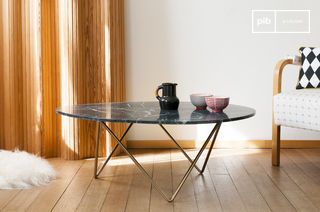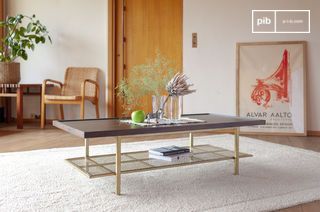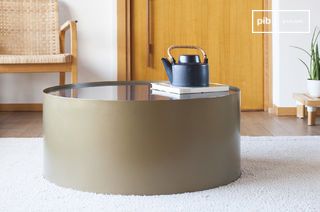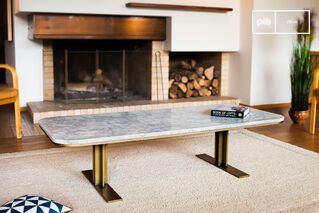Gold coffee tables
Gold-plated coffee tables introduce a visible metallic point into the composition of the living room. A gilded coffee table relies on the use of a brass, light bronze or treated metal finish, applied to the base, top or entire structure. This treatment partially reflects the light, creating direct contrasts with the surrounding matte materials. The table is rigidly or tubularly assembled, often in combination with glass, marble or dark wood. This type of table requires careful visual organization to avoid overloading the space. read more >
Filters

Green marble coffee tableTrivisan
£725 £650-10%

Walnut coffee tableNeutra
£845 £760-10%

Round marble coffee tableDickinson
£1210 £1090-10%

Understanding the visual function of a gold coffee table
A gold coffee table functions as a point of visual tension in the living room. Its metallic finish draws the eye without necessarily playing up the color. Gold can be applied to the entire structure or just the base, depending on the model's configuration. It is often used to introduce a textural variation rather than a direct luminous effect. Depending on the finish (brushed, satin, gloss), the effect can range from a punctual glow to a markedly reflective surface.
This typology blends into balanced environments, with a controlled interplay of materials. Gold can extend a hue present elsewhere in the room (brass on a lamp, metal frame, textile detail) or create a distinct visual focal point. Its presence requires consideration of the quantity of shiny or metallic elements in the space. Too isolated, it can appear decorative. Too repeated, it loses its landmark function.
Formats, layout and common associations
Golden coffee tables come in compact or elongated formats. The shape of the top is often simple (round, oval, rectangular), letting the metal structure the effect. A gilded base can take the form of a tubular base, a welded frame or a sculpted element. The top, in glass, marble or stained wood, contrasts or contrasts with the finish chosen. A clear glass top reveals the structure, accentuating the presence of gold. A dark top creates a more pronounced mass effect.
These models are generally positioned in the center of the living room, on a plain or sparsely patterned rug to maintain a clear reading. The combination with matte fabric or leather seats balances the shiny appearance of the metal. In brightly lit rooms, a brushed or patinated finish limits direct reflections. In darker interiors, polished metal reflects artificial light and energizes the composition.
Height varies between 30 and 40 cm, in line with coffee table standards. Some golden tables are designed as a duo or nested composition, with two levels or two complementary formats. This option makes it possible to modulate the useful surface while adapting the visual reading of gilding throughout the room.
Materials, maintenance and shelf life
The gilded treatment is generally applied to a steel or aluminum base. It can be plated, galvanized or metallic paint. Resistance to scratching and oxidation depends on the method used. Solid brass models are rarer, heavier and require specific maintenance. In all cases, the metal should be cleaned with a soft cloth, without abrasives or acidic products.
The associated trays should also be chosen according to their intended use. Glass is sensitive to thermal shock and should be wiped down regularly. Marble requires non-aggressive maintenance to preserve its appearance. Stained wood, if combined with a bright gold, creates a stable visual base that partially absorbs light.
The golden coffee table remains an everyday piece of furniture, provided its finish is adapted to the intensity of use. It should not be perceived as a fragile or decorative element only. Its appeal lies in its ability to incorporate visible metal without imposing a precious or ornamental effect.
Choosing a gilded coffee table means inserting a legible metallic point into the structure of the living room. It acts as a controlled element of contrast, to be integrated into a sober or structured composition. Its placement and its association with other materials determine its role in the overall reading of the space.
